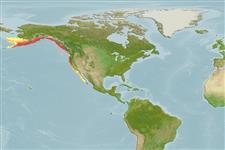Actinopterygii (ray-finned fishes) >
Scorpaeniformes (Scorpionfishes and flatheads) >
Sebastidae (Rockfishes, rockcods and thornyheads) > Sebastinae
Etymology: Sebastes: Greek, sebastes = august, venerable (Ref. 45335); brevispinis: From the Latin brevis and spinus, meaning 'short' and 'spine' (Ref. 27436).
Environment / Climate / Range
Ecology
Marine; demersal; depth range 0 - 375 m (Ref. 6793). Subtropical, preferred ?; 60°N - 23°N, 178°W - 110°W
Northeast Pacific: Bering Sea coast of Alaska (Ref. 27436) to Baja California, Mexico.
Length at first maturity / Size / Weight / Age
Maturity: Lm 46.0 range ? - ? cm
Max length : 71.0 cm TL male/unsexed; (Ref. 2850); max. published weight: 4.7 kg (Ref. 40637); max. reported age: 82 years (Ref. 39247)
Dorsal
spines
(total): 13;
Dorsal
soft rays
(total): 15-17;
Anal
spines: 3;
Anal
soft rays: 7 - 8. Head spines weak - nasal, preocular and parietal spines present, supraocular, postocular, tympanic, coronal and nuchal spines absent (Ref. 27437). Lower jaw long and protruding beyond upper jaw; distinct symphyseal knob; maxillary extends to rear of orbit (Ref. 27437). Caudal fin indented (Ref. 6885). Greenish to silver gray, white tinged with orange or pink ventrally; lips dusky (Ref. 27437).
Occur just above the bottom, sometimes found in rocky caverns and crevices (Ref. 27436). Ovoviviparous (Ref. 6885). Rarely caught by anglers (Ref. 27436). Filleted and sold indiscriminately with other rockfish; flavor and texture of flesh particularly good (Ref. 27436).
Ovoviviparous (Ref. 6885). Also Ref. 34817.
Eschmeyer, W.N., E.S. Herald and H. Hammann, 1983. A field guide to Pacific coast fishes of North America. Boston (MA, USA): Houghton Mifflin Company. xii+336 p. (Ref. 2850)
IUCN Red List Status (Ref. 115185)
CITES (Ref. 94142)
Not Evaluated
Threat to humans
Harmless
Human uses
Fisheries: commercial
More information
ReferencesAquacultureAquaculture profileStrainsGeneticsAllele frequenciesHeritabilityDiseasesProcessingMass conversion
Tools
Special reports
Download XML
Internet sources
